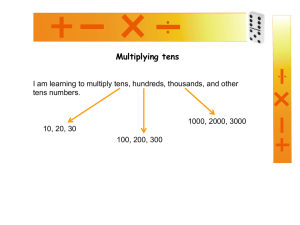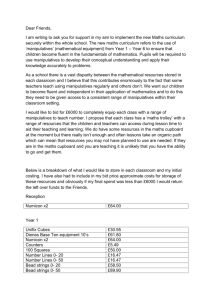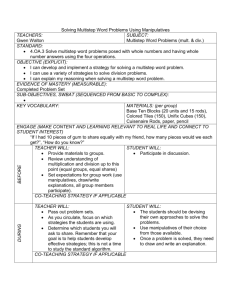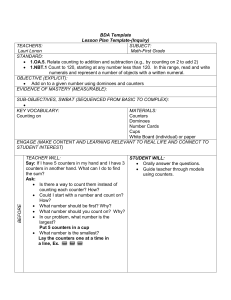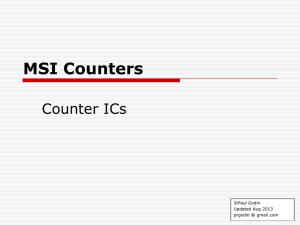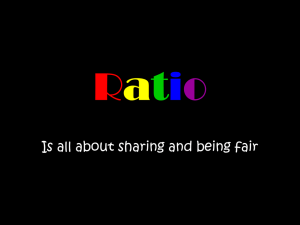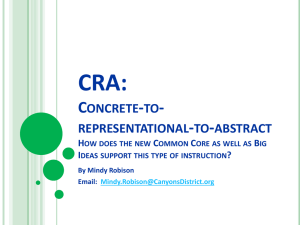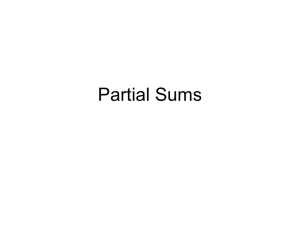Manipulatives, Mastery and Calculation
advertisement
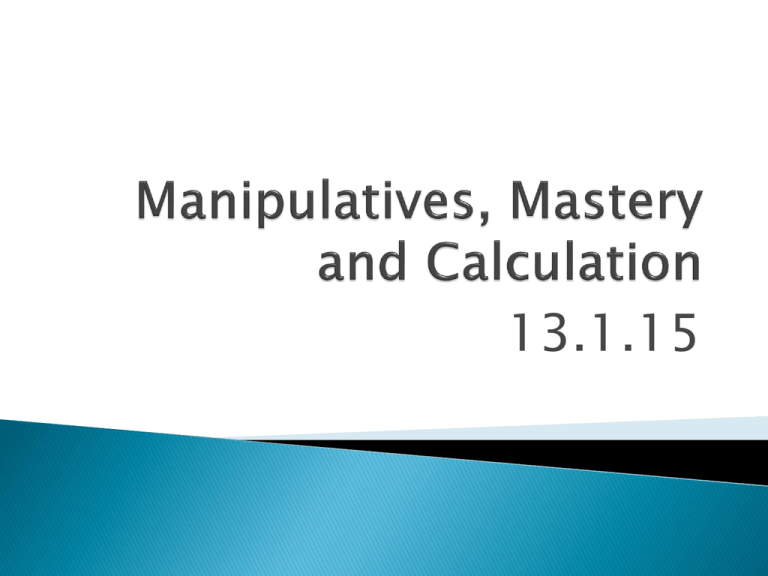
13.1.15 To understand what is a manipulative To understand the mastery approach To consider a progressive calculation policy To know ways you can use manipulatives in your own setting Manipulatives are all practical bits of equipment that children can pick up and manipulate to help them get to grips with the very abstract notions of numbers, the relationships between them and the ways in which they work in the number system. Some examples include Multilink cubes, Dienes apparatus, counters, place value counters, bead strings, Cuisenaire rods, sticks divided into 10 equal sections and also those that use numerals such as place value cards, hundred squares, digit cards, dice, dominoes and so on. Bead strings Dienes Cuisenaire Rods Numicon Place value counters Place value arrow cards In 2012 the OECD’s PISA study found that Shanghai and Singapore topped the table, with students scoring the equivalent of nearly 3 years of schooling above most other OECD counties. The top performing countries all use a mastery curriculum approach. The findings highlight that our children’s current achievements in mathematics are not the best they can be. A mastery approach is about closing the gap between our highest and lowest achievers, also about raising achievement for all. The aim is to teach every concept or skill in a way that promotes understanding and problem solving so it is not a collection of memorised techniques but a coherent body of interconnected knowledge that can be flexibly applied to solve problems in unfamiliar contexts. Deepening conceptual understanding through the use of physical and pictorial representations (Very effective in countries such as Singapore & Netherlands) Developing pupils’ communication, through explicitly teaching pupils’ to discuss mathematics through grammatically correct full sentences with accurate vocabulary (A key priority in Asian countries) Encouraging pupils to think like mathematicians through giving them opportunities to seek patterns and rules, and ask and answer questions A cumulative curriculum, with sufficient time for every child to access age appropriate concepts and skills. Involves supporting and challenging pupils through depth. Involves purposeful planning that considers the use of different manipulatives and representations. All children working on the same learning intention at the same time. A policy that has been updated to mirror the new national curriculum expectations. It was designed in collaboration by different maths experts. It is a progressive approach to teaching mathematics across a school. Each school can then supplement strategies and resources at their own discretion. Maths Leaders from each school will meet to discuss the implementation of the policy, including misconceptions, hesitations and learning implications. The next step will be to raise people’s understanding of the pedagogical choices teachers have and reasoning behind certain aspects such as using a blank number line and teaching grouping and not sharing. Fractions: Division: Cuisenaire rods for fractions Have a go! “The bottom number is the denominator. That tells you how many equal parts it is divided up in to. The top number is the numerator, the fraction part” Hajra “6/4 is equivalent to 1 2/4 and 1 ½” Holly “When the numerator matches the denominator that means it’s one whole” Arafath “2 ¼ that’s a mixed fraction” Pitro “ If the white rod is ¼ the dark green rod is six lots of a ¼, that means it is 6/4” Ellie Place Value Counters for Division Teach explicitly vocabulary for the unit then build in opportunities and time for conversations about the maths using the correct vocabulary. Calculate division mentally. At first the children needed to use jottings to support their thinking. This was over several lessons until all children had a clear understanding. Children were challenged through applying the skills to real life word problems. Design a series of lessons with a clear learning intention for each. Other examples 369 ÷ 3 = 488 ÷ 4 = Have a go! The children were set this calculation as a problem to discuss before I started any direct teaching. The children worked in pairs and used manipulatives. Responses included… “Use the counter to show the dividend” “We can make one group of 6 with the hundreds but what do we do now?” “We could exchange the ten like we do in subtraction” “Zero is the place holder” Daniel and Alhosna who are Year 4 working just below MARE could solve and explain how to solve. “First I made 832 with my place value counters. I knew I had to make groups of 8 because 8 is the divisor, 832 is the dividend, the big number. With the hundreds, I had one group of 8. I wrote that to start the answer. I then looked at the tens, I only had 3 so I had to write zero as a place holder. I then exchanged 3 tens for 30 units making it 32. I then put the units into groups of 8. I checked with my times table knowledge. Each time I had four groups. The quotient or answer is 104.” Tyreke Year 4 (Working at ARE) Children used the place value counters to illustrate their understanding of division with larger numbers To begin my learning intention include using the manipulatives and reasoning. Can I use manipulatives to…. Can I use my reasoning skills to…. As children master a skill it is their decision when to move away from manipulatives, then on to pictorial representation and then the abstract. 446 ÷ 4 = Children first discussed in pairs if this calculation would have a remainder and how they knew. Children used their reasoning skills to estimate and predict even before they got out the place value counters. Children have become more enthusiastic about maths. It has supported all children with their speaking and listening as they feel empowered by their deeper understanding of number. Some of our reluctant speakers are now so engaged they want to talk about their maths all day long! With a high number of children with EAL and new arrivals to England we have found it has supported the children to demonstrate their understanding even when they can’t yet verbalise it. Using images and manipulatives has supported SEN children, those who are just below MARE and reluctant mathematicians. They are now more engaged, talk more about their learning and show their understanding more clearly. “The counters help me see what is happening” – Kelsie 1B – 2B “The place value counters help me to subtract when you have to take a ten from the tens column and then put it in the units. I like changing the ten in to units” Tyreke 2A – 3C “I get Dienes out and pick them up. I count in ones, the sticks in tens and the squares in hundreds. It helps me remember. I can add and take away big numbers now.”– Aiden P8 – 1A “When I have a tricky calculation I use the place value counters to help me get the numbers in my mind. It helps me remember” – Ellie 2A – 3A “They help me (Cuisenaire rods) add and subtract fractions because the rods are different colours and you can see. I liked finding things out by myself and then talking to my friends about it” – Sophie 2A – 3A “My Maths is on fire!” Tyreke “First I made 832 with my place value counters. I knew I had to make groups of 8 because 8 is the divisor, 832 is the dividend, the big number. With the hundreds, I had one group of 8. I wrote that to start the answer. I then looked at the tens, I only had 3 so I had to write zero as a place holder. I then exchanged 3 tens for 30 units making it 32. I then put the units into groups of 8. I checked with my times table knowledge. Each time I had four groups. The quotient or answer is 104.” Tyreke Yr4 (Working at MARE)
